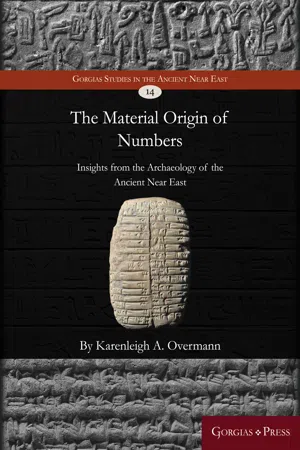
The Material Origin of Numbers
Insights from the Archaeology of the Ancient Near East
- 327 pages
- English
- PDF
- Available on iOS & Android
The Material Origin of Numbers
Insights from the Archaeology of the Ancient Near East
About This Book
What are numbers, and where do they come from? These questions have perplexed us for centuries, if not millennia. A novel answer is suggested by cognitive archaeologist Karenleigh A. Overmann, based on her groundbreaking study of material devices used for counting in the Ancient Near East—fingers, tallies, tokens, and numerical notations—interpreted through the latest neuropsychological insights into human numeracy and literacy. The result is a unique synthesis of data from archaeology, Assyriology, neuroscience, ethnography, linguistics, philosophy of mind, and the history of mathematics. It outlines how number concepts were realized and elaborated through the use of material forms during a period spanning the late Upper Paleolithic to the Bronze Age, from the first realization of number in a pristine original condition to their elaboration as one of the ancient world's greatest mathematical traditions, a foundation for mathematical thinking today. In this view, numbers are abstract from their inception and materially bound at their most elaborated. The research updates historical work on Neolithic tokens and interpretations of Mesopotamian numbers, challenging several longstanding assumptions about numbers in the process. The insights generated are also applied to the role of materiality in human cognition more generally, including how concepts become distributed across and independent of the material forms used for their representation and manipulation; how societies comprised of average individuals use material structures to create elaborated systems of numeracy and literacy; and the differences between thinking through and thinking about materiality.
Frequently asked questions
Information
Table of contents
- TABLE OF CONTENTS
- FIGURES AND TABLES
- CONVENTIONS
- ACKNOWLEDGEMENTS
- CHAPTER 1. INTRODUCTION
- CHAPTER 2. NUMBERS THROUGH A DIFFERENT LENS
- CHAPTER 3. WHAT’S A NUMBER, REALLY?
- CHAPTER 4. ASSEMBLING AN ELEPHANT, ONE BIT AT A TIME
- CHAPTER 5. BEHAVIORAL TRACES
- CHAPTER 6. LANGUAGE IN HOLISTIC CONTEXT
- CHAPTER 7. ANCIENT LANGUAGES AND MESOPOTAMIAN NUMBERS
- CHAPTER 8. FINGERS AND TALLIES
- CHAPTER 9. THE NEOLITHIC CLAY TOKENS
- CHAPTER 10. NUMERICAL NOTATIONS AND WRITING
- CHAPTER 11. THE ROLE OF MATERIALITY IN NUMERICAL CONCEPTS
- CHAPTER 12. CONCLUDING REMARKS AND QUESTIONS
- APPENDIX: DATA TABLES
- BIBLIOGRAPHY
- INDEX